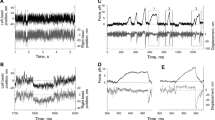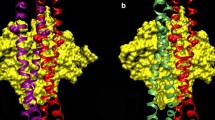Summary
The contractile ATPase of artificial actomyosin (reconstituted from its purified components actin and myosin) is fully active even at low concentrations (∼10−9 M) of ionized calcium. Natural tropomyosin, the physiological inhibitor, however, inhibits the contractile ATPase under these conditions. Natural tropomyosin which is not further purified by ammonium sulfate precipitation inhibits also at higher concentrations (10−6 M) of Ca++.
-
2.
Natural tropomyosin which is prepared by ammonium sulfate precipitation inhibits at high concentrations of Ca++ if it is briefly digested by trypsin.
-
3.
Natural tropomyosin influences the interaction between actomyosin and MgATP in such a way that the affinity of actomyosin for MgATP increases, the maximal splitting rate, however, decreases. Hence, substrate inhibition can already be seen at concentrations that are otherwise optimal.
-
4.
Natural tropomyosin affects the ITPase of actomyosin in a similar manner if the inhibitory activity of tropomyosin is mediated by the concentration of free Ca++. The ITPase activity of the actomyosin-tropomyosin complex, however, is even at high concentrations of free Ca++ lower than the ITPase activity of pure actomyosin.
Similar content being viewed by others
References
Azuma, N., Watanabe, S.: The minor component of metin from rabbit skeletal muscle. J. biol. Chem.240, 3852–3867 (1965).
Bailey, K.: Tropomyosin, a new asymmetric protein component of the muscle fibril. Biochem. J.43, 271–278 (1948).
Bendall, J. R.: Relaxation of glycerol-treated muscle fibers by ethylenediamine tetraacetate. Arch. Biochem.73, 283–285 (1958).
—: A study of the kinetics of the fibrillar ATP-ase of rabbit skeletal muscle. Biochem. J.81, 520–535 (1961).
—: Muscles, molecules and movement. London: Heinemann 1969.
Dancker, P.: Ein natürlicher Hemmfaktor der Aktomyosin-ATPase und die Abhängigkeit seiner Wirkung von der Calcium-Konzentration. Pflügers Arch. ges. Physiol.294, 45 (1967).
Ebashi, S.: Third component participating in the superprecipitation of natural actomyosin. Nature (Lond.)200, 1010 (1963).
—, Ebashi, F.: A new protein component participating in the superprecipitation of myosin B. J. Biochem. (Tokyo)55, 604–613 (1964).
—, Endo, M.: Calcium ion and muscle contraction. Progr. Biophys.18, 123–183 (1968).
—, Kodama, A.: A new protein factor promoting aggregation of tropomyosin. J. Biochem. (Tokyo)58, 107–108 (1965).
——, Ebashi, F.: Troponin. I. Preparation and physiological function. J. Biochem. (Tokyo)64, 465–477 (1968).
Hartshorne, D. J., Perry, S. V., Davies, V.: A factor inhibiting the adenosine triphosphatase activity and the superprecipitation of actomyosin. Nature (Lond.)209, 1352–1353 (1966).
——, Schaub, M. C.: A protein factor inhibiting the magnesium-activated adeno-, sine triphosphatase of desensitized actomyosin. Biochem. J.104, 907–913 (1967).
—, Theiner, M., Mueller, H.: Studies on troponin. Biochim. biophys. Acta (Amst.)175, 320–330 (1969).
Hasselbach, W.: Die Umwandlung von Aktomyosin-ATPase in L-Myosin-ATPase durch Aktivatoren und die resultierenden Aktivierungseffekte. Z. Naturforsch.7 b, 163–174 (1952).
—: Die Wechselwirkung verschiedener Nukleosidtriphosphate mit Aktomyosin im Gelzustand. Biochim. biophys. Acta (Amst.)20, 355–368 (1956).
Iyengar, R., Weber, H. H.: The relative affinities of nucleotides to g-actin and their effects. Biochim. biophys. Acta (Amst.)86, 543–553 (1964).
Levy, H. M., Ryan, E. M.: Evidence that calcium activates the contraction of actomyosin by overcoming substrate inhibition. Nature (Lond.)205, 703–705 (1965).
Perry, S. V.: The structure and interactions of myosin. Progr. Biophys.17, 325–381 (1967).
—, Davies, V., Hayter, D.: “Natural” tropomyosin and the factor sensitizing actomyosin adenosine triphosphatase to ethylenedioxybis(ethyleneamino) tetraacetic acid. Biochem. J.99, 1c-2c (1966).
— Grey, T. C.: Ethylenediaminetetra-acetate and the adenosine triphosphatase activity of actomyosin systems. Biochim. J.64, 5 P (1956).
Rockstein, M., Herron, P. W.: Colorimetric determination of inorganic phosphate in microgram quantities. Analyt. Chem.23, 1500–1501 (1951).
Schaub, N. C., Hartshorne, D. J., Perry, S. V.: Effect of tropomyosin on the calcium-activated adenosine triphosphatase of actomyosin. Nature (Lond.)215, 635–636 (1967).
Weber, A.: Parallel response of myofibrillar contraction and relaxation to four diffent nucleoside triphosphates. J. gen. Physiol.53, 781–783 (1969).
Author information
Authors and Affiliations
Rights and permissions
About this article
Cite this article
Dancker, P. Natural tropomyosin as a physiological inhibitor of the contractile activity of actomyosin. Pflugers Arch. 315, 187–197 (1970). https://doi.org/10.1007/BF00586412
Received:
Issue Date:
DOI: https://doi.org/10.1007/BF00586412




